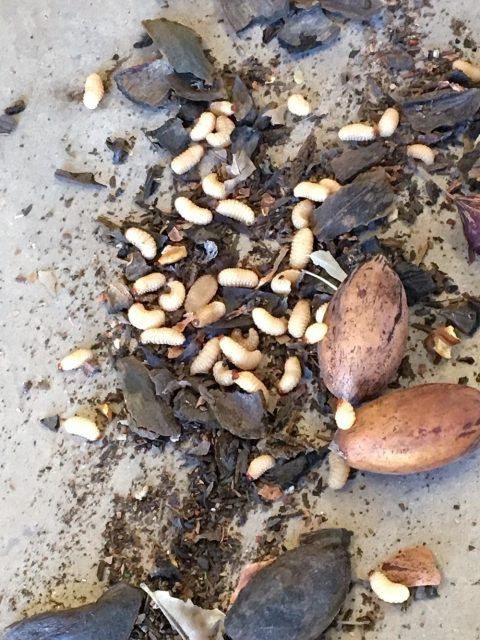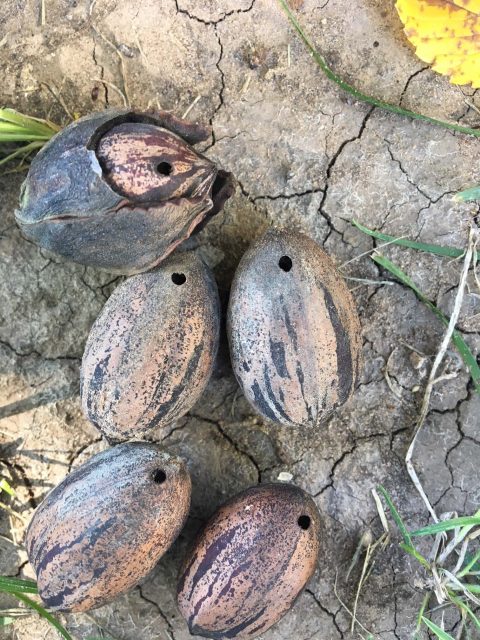FOR IMMEDIATE RELEASE:
Contact: Kristie Garcia
Director of Public Affairs, New Mexico Department of Agriculture
krgarcia@nmda.nmsu.edu
Office: 575-646-2804
Cell: 575-339-5011
Jan. 23, 2023
NMDA asks pecan consumers, growers to be aware of pecan weevil
Pecan weevil quarantines in effect
LAS CRUCES, N.M. – As part of an ongoing commitment to prevent the spread of pecan weevil, New Mexico Department of Agriculture (NMDA) officials ask pecan growers and consumers to be aware of pecan weevil. Pecan weevil is considered the most significant pecan pest of pecan growers, regardless of the number of trees, due to the severe crop damage it can cause.
“For over 40 years, the New Mexico Department of Agriculture and the New Mexico Pecan Growers Association have diligently worked together to prevent the spread of pecan weevil and, ultimately, protect this valuable crop,” said New Mexico Secretary of Agriculture Jeff Witte. “I commend everyone involved through the years that has monitored for the weevil, reported suspect pecans, inspected pecans, provided outreach and education, and maintained awareness of this pest and the quarantines that are in place.”

Pecan Weevil Interior and Exterior Quarantines
Both interior and exterior pecan weevil quarantines are in effect in New Mexico. The pecan weevil interior quarantine applies to Chaves, Eddy, Lea and Otero Counties and includes several restrictions to moving in-shell pecans and related articles from these counties to other counties. Related articles include equipment, and now that it’s pruning season, it’s important to know that pecan-related pruning equipment that has operated in quarantined counties – and will be transported to or through non-quarantined counties of the state – is required to be inspected and obtain a certificate identifying the equipment as believed not to be infested with pecan weevil.
The pecan weevil exterior quarantine restricts the movement of in-shell pecans and regulated articles into New Mexico from all states except Arizona, California and the Texas counties of Culberson, El Paso, Hudspeth, Jeff Davis and Presidio. In-shell pecan originating in the aforementioned states and counties are required to obtain a certificate of origin from that state’s department of agriculture prior to shipment.
The interior and exterior quarantine rules may be viewed in their entirety on the NMDA website.
For Consumers
Many well-intended friends and family may ship in-shell pecans to relatives and friends in New Mexico as gifts. It’s important to be aware of where those pecans came from and whether that location is a quarantined area. If consumers in New Mexico receive in-shell pecans from a quarantined state or county, as a precaution, they should freeze the pecans as prescribed in the pecan weevil exterior quarantine rule.
For Growers
Although the harvest season has – for the most part – ended, it’s important that growers are aware that equipment should be cleaned, especially with pruning season in full swing. New Mexico growers who plan to ship in-shell pecans to other counties, states or countries should be informed regarding which counties are part of the interior quarantine rule, what precautions should be taken and what treatments are acceptable. Should you require moving in-shell pecans from a quarantined county to a non-quarantined county for cold storage treatment, you will need to receive a compliance agreement before shipping any pecans. Contact NMDA Entomology & Nursery Industries at 575-646-3207 or pecan@nmda.nmsu.edu for compliance agreements and related questions.
NMDA officials reiterate the importance of monitoring for pecan weevil. “I encourage all growers to be good neighbors and help the state prevent the pecan weevil from spreading,” said Witte. “We ask that pecan tree owners to be diligent about inspecting shells for holes that may indicate pecan weevil presence. We appreciate everyone’s effort toward prevention.”

What to Look for
The most common way pecan weevil is found is looking for the exit hole in the nut during harvest season. The exit hole is chewed from the inside of the nut by pecan weevil larvae to allow them to leave the nut and burrow into the ground where they spend the majority of their lifecycle. The exit hole produced by pecan weevil larvae is a very round, BB-sized hole and often times is surrounded by a dark halo.
NMDA asks owners of pecan trees, both residential and commercial, to inspect their pecan nuts for holes possibly caused by pecan weevil. Commercial growers can concentrate their inspection efforts by inspecting lower grades of nuts that are typically lighter in weight and separated by an airleg. Should you find any suspect pecans, NMDA asks you to do the following:
- Do not crack the pecans, as it makes it more difficult for specialists to determine the source of damage;
- Submit images of suspect pecans to pecan@nmda.nmsu.edu;
- Place suspect pecans in a bag or container and store in a freezer. Should your submitted image require further inspection, the response email will provide further instruction on the submission process.
For more information, please email pecan@nmda.nmsu.edu or call at 575-646-3207.
###
Find us at:
Please bookmark the new NMDA website: NMDeptAg.nmsu.edu
Facebook, Twitter and Instagram: @NMDeptAg
YouTube: NMDeptAg
LinkedIn: New Mexico Department of Agriculture
